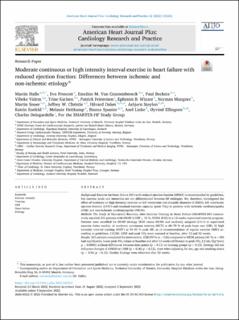Moderate continuous or high intensity interval exercise in heart failure with reduced ejection fraction: Differences between ischemic and non-ischemic etiology
Halle, Martin; Prescott, Eva Bossano; Craenenbroeck, Emeline M Van; Beckers, Paul; Videm, Vibeke; Karlsen, Trine; Feiereisen, Patrick; Winzer, Ephraim B.; Mangner, Norman; Snoer, Martin; Christle, Jeffrey W.; Dalen, Håvard; Støylen, Asbjørn; Esefeld, Katrin; Heitkamp, Melanie; Spanier, Bianca; Axel, Linke; Ellingsen, Øyvind; Delagardelle, Charles
Peer reviewed, Journal article
Published version

Åpne
Permanent lenke
https://hdl.handle.net/11250/3047388Utgivelsesdato
2022Metadata
Vis full innførselSamlinger
Originalversjon
American Heart Journal Plus: Cardiology Research and Practice (AHJ Plus). 2022, 22 . 10.1016/j.ahjo.2022.100202Sammendrag
Background
Exercise for heart failure (HF) with reduced ejection fraction (HFrEF) is recommended by guidelines, but exercise mode and intensities are not differentiated between HF etiologies. We, therefore, investigated the effect of moderate or high intensity exercise on left ventricular end-diastolic diameter (LVEDD), left ventricular ejection fraction (LVEF) and maximal exercise capacity (peak VO2) in patients with ischemic cardiomyopathy (ICM) and non-ischemic cardiomyopathy (NICM).
Methods
The Study of Myocardial Recovery after Exercise Training in Heart Failure (SMARTEX-HF) consecutively enrolled 231 patients with HFrEF (LVEF ≤ 35 %, NYHA II-III) in a 12-weeks supervised exercise program. Patients were stratified for HFrEF etiology (ICM versus NICM) and randomly assigned (1:1:1) to supervised exercise thrice weekly: a) moderate continuous training (MCT) at 60–70 % of peak heart rate (HR), b) high intensity interval training (HIIIT) at 90–95 % peak HR, or c) recommendation of regular exercise (RRE) according to guidelines. LVEDD, LVEF and peak VO2 were assessed at baseline, after 12 and 52 weeks.
Results
215 patients completed the intervention. ICM (59 %; n = 126) compared to NICM patients (41 %; n = 89) had significantly lower peak VO2 values at baseline and after 12 weeks (difference in peak VO2 2.2 mL/(kg*min); p < 0.0005) without differences between time points (p = 0.11) or training groups (p = 0.15). Etiology did not influence changes of LVEDD or LVEF (p = 0.30; p = 0.12), even when adjusting for sex, age and smoking status (p = 0.54; p = 0.12). Similar findings were observed after 52 weeks.
Conclusions
Etiology of HFrEF did not influence the effects of moderate or high intensity exercise on cardiac dimensions, systolic function or exercise capacity.
